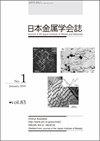高電流密度下における硫酸酸性浴からの Zn-Ni 合金析出挙動
IF 0.5
4区 材料科学
Q4 METALLURGY & METALLURGICAL ENGINEERING
引用次数: 5
Abstract
The electrodeposition behavior of Zn-Ni alloys produced from acidic sulfate solutions was investigated from partial polarization curves obtained during alloy electrodeposition. At the current density at which the co-deposition of Zn-Ni alloys produced anomalous results, we found that Zn deposition is polarized and is affected by the bath Zn concentration and ow rate. This indicates that Zn deposition is controlled by diffusion at high current densities. Under the conditions for increased Zn deposition, Ni deposition was not suppressed even in the region of anomalous co-deposition. With a low pH bath, the Ni concentration in the deposit did not increase under a high current density because of strong suppression of Ni deposition under the low pH condition. [doi:10.2320/matertrans.M2016253]高电流密度下从硫酸酸性浴中析出Zn-Ni合金的行为
利用合金电沉积过程中获得的部分极化曲线,研究了酸性硫酸盐溶液制备Zn-Ni合金的电沉积行为。在Zn- ni合金共沉积产生异常结果的电流密度下,我们发现Zn的沉积是极化的,并受镀液Zn浓度和电流速率的影响。这表明在高电流密度下,锌的沉积是由扩散控制的。在Zn沉积增加的条件下,即使在异常共沉积区域,Ni的沉积也没有受到抑制。在低pH条件下,在高电流密度下,由于低pH条件下对Ni沉积有较强的抑制作用,沉积层中的Ni浓度没有增加。(doi: 10.2320 / matertrans.M2016253)
本文章由计算机程序翻译,如有差异,请以英文原文为准。
求助全文
约1分钟内获得全文
求助全文
来源期刊

Journal of The Japan Institute of Metals
工程技术-冶金工程
CiteScore
0.70
自引率
0.00%
发文量
27
审稿时长
6-12 weeks
期刊介绍:
Information not localized
 求助内容:
求助内容: 应助结果提醒方式:
应助结果提醒方式:


